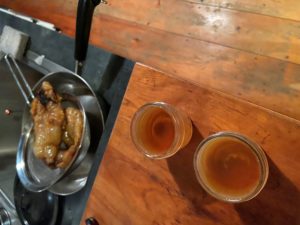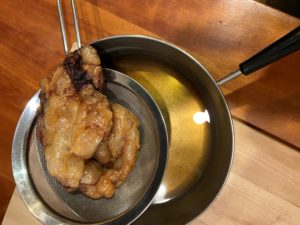
Rendering Veal Fat
Article by Robin Kerber
Lard, tallow, butter… these words have a dirty reputation thanks to mainstream claims that these natural fats are bad for our health and our hearts. But if we take a closer look at these exaggerated ideas, many originated from a time when wealthy and powerful processed food companies like Crisco and Parkay (makers of hydrogenated vegetable oil) had a lot of influence in the American diet.
These companies began mass producing hydrogenated vegetable oils that behaved similarly to their natural, animal fat counterparts, except they had an increased shelf life, were inexpensive, and contained nasty trans fat. In an attempt to inspire all American housewives to swap out their tubs of lard for highly-processed and chemically-manipulated shortening, Crisco and Parkay in partnership with national health organizations ran a successful marketing campaign that bashed animal fats and successfully persuaded cooks across the country that saturated animal fat is an unhealthy option.
While shortening was deemed a revolution in health food and a healthier alternative to animal fats, more recent studies have shown that this highly processed food deserves no place in our kitchens, homes, or bodies.
Thankfully the use of lard, tallow, and butter has seen a revival in American cooking. With this re-discovery has also come an interest in sourcing high quality, organic and local ingredients from farms that practice sustainable and regenerative agriculture.
While your great-great-grandmother rendered lard and tallow and didn’t have access to refrigeration like we do, I still recommend that you store your finished fat in the fridge or freezer. Even the finest strainer or cheesecloth will allow bits of impurities pass through with the fat. These sometimes microscopic pieces of meat, cartilage, etc. can spoil the fat and cause it to go rancid – unless you store in the fridge of freezer! So why risk it?
Whether your cast iron skillet is brand new or just in need of a deep seasoning, I always use rendering animal fat as an opportunity to heat and season my pans. The low heat of the oven paired with multiple hours of slow rendering and fat absorption is ideal for cast iron. Plus, when you’re done, you have a hot, fatty skillet ready to fry up supper!
Best uses for animal fat:
- Fried chicken (or anything deep fried… tallow and lard has a very high smoke point)
- The flakiest pie crusts and biscuits
- Any old recipe that calls for shortening – swap it out for lard!
- Traditional refried beans or tamales
- Seasoning cast iron
- Adding a savory flavor to just about anything!
- Roll set tallow into a tray of birdseed and hang from tree branches to feed your outdoor friends
How to render veal or beef suet into tallow:
- Chop cold suet into equal-sized pieces (or leave whole like I did, if you’re feeling lazy)
- Fill cast iron skillet with suet chunks and place in oven
- Turn oven up to 200 degrees Fahrenheit
- Suet will slowly melt and separate from the solid, non-fat particles

- Check on the melting suet every hour, stirring occasionally
- While suet is melting, set up your sterilized jars or food storage containers. Once melted, you will need to work quickly to fill the containers before the fat cools and solidifies.
- When the tallow has fully melted, carefully remove skillet from oven
- Strain through fine mesh chinois or cheesecloth into a liquid measuring cup or something you can easily pour from
- Fill sterilized jars or clean food storage containers with hot tallow
- Allow fat to fully cool and solidify before capping

- Store in refrigerator or freezer. The exact shelf life will depend on how many impurities you were able to strain out, but most tallow will last a VERY long time in the freezer.




